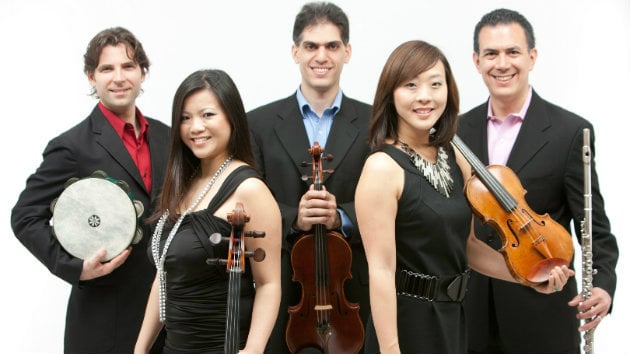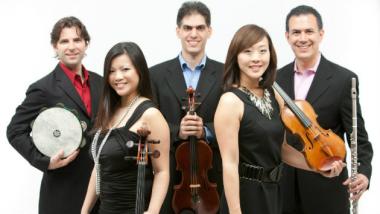
Classical music, as we know it, is built from a written score, and musicians are more or less tied to it, acting as conduits for the composer. While they are amazing readers of notes, most classical musicians shy away from improvisation. In other genres, by contrast, musicians may or may not be able to read music but can improvise amazing solos, blending into the groove by ear. Then there are musicians who are comfortable in both worlds, like the players of Classical Jam.
Only the first piece of the group’s Sunday night performance at the Kohl Mansion in Burlingame was in the traditional, classical format: Albert Roussel’s Trio for Flute, Viola, and Cello was exquisite. Roussel, a contemporary of Debussy, wrote music that is charming, expertly contrapuntal, and full of French-style musical colors and textures. Flautist Marco Granados played with crisp clarity on high tones and mellow full-bodied low notes. Violist Erin Wight delivered open-hearted expression and amazing facility on her instrument. Classical Jam founder and artistic director Wendy Law rounded out the group on cello. In the third movement the strings played a series of repeating harmonics to form a crystalline surface over which the flute glided in a breathtaking set of melodies — a highlight of the concert.
Granados and violinist Cyrus Beroukhim then teamed up to play a mind-boggling encore attributed to Mozart, Table Top Music. The piece is a 2-minute, cerebral exercise about the art of putting notes on a musical staff and is played from one sheet of score, with the second violin reading the same music upside down. The pair made obvious the exact meeting point of the duet’s two mirror images, clarifying the symmetry.
In between the movements of Ernő Dohnányi's String Trio, percussionist Justin Hines read excerpts from a journal entry by a violinist who premiered the piece in a salon for the composer. Hines spoke from the back of the hall through the loudspeakers with reverb on his voice, creating a cinematic voiceover effect. It was well executed and really carried my imagination into the scene, adding a layer of meaning to the music. The trio played together with great chemistry and would have been satisfying even without the narration.
Johan Halvorsen’s Passacaglia is based on a bass line by Handel. It is a popular but difficult duet for violin and viola or violin and cello. Classical Jam arranged the duet for a quartet, snipping up the music and dividing it among the players to form a musical ping-pong effect. The divided responsibilities make the piece easier, and it was most exciting when they added notes on top of Halvorsen’s. It was great to hear three layers of different composers and arrangers creating a piece simultaneously new and familiar.
In the second half, Hines moved from emcee duties to percussionist. Percussion instantly changed the vibe, sonic balance, and rhythmic feel of the music. After a spirited Piazzolla tango, the group played parts of The Hours movie score by Philip Glass, but toned down on the repetition and made the piece sound more Romantic than minimalist.
The Art of Fugue was one of J.S. Bach’s last pieces. It is a compositional study, showcasing different types of fugues on the same subject. Bach left it unfinished, which has long been an invitation for further elaboration. Classical Jam is unafraid to tinker with and rework hallowed musical literature, and here they took an entirely different direction. Breaking from Bach’s serious counterpoint to American blues, each player took a turn at improvisation before coming back to Bach, this time in a swing rhythm.
Samai’i Shira, by Hines, is based on Middle Eastern music. The composer provided desert flavor with his Udu and Doumbek drums while the strings played meandering lines. Middle Eastern music is usually monophonic and based on microtonally altered modes (Maqms). Hines couldn’t resist adding western harmony. Arabic musicians also play with a raspier tone and sometimes with different tunings, which creates a distinct timbre. They seldom play from the written page. These differences made the piece less convincing than it could have been.
In the final selection, The Hibiee Jibiees by Marco Granados, Jackeline Rago joined the group for a mesmerizing maracas introduction, which yielded a feverish Venezuelan dance number.
Traditionalists may turn their noses up at the breaking of the pure classical format, but I enjoyed hearing performers who are also composers and improvisers. It was interesting to compare read music and improvised music side by side. Classical Jam is more of a collective of musicians than a set ensemble. The group has been tirelessly performing at schools and community centers all over the Bay Area, and all that hard work has bound the team together.

